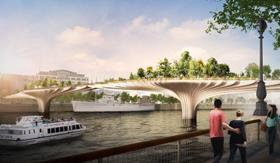Thomas Heatherwick’s projects spark regeneration and his latest is no different

So the House of Lords see the new Garden Bridge designed by Thomas Heatherwick as a ‘vanity project’. I guess if you are the sort of person who believes that smartening yourself up and adding a bit of delight to your appearance is vanity, then so be it. But if you look seriously at the changing nature of cities and the role of London in the global economy, then you might say that it makes good sense.
It is no secret that Boris’s attraction to this idea is his desire to trump the success of New York’s High Line – an inspiring urban intervention which has transformed the west side of Manhattan and changed the movement patterns of the city.
One only has to look at the transformative impact of the Millennium Bridge on the fortunes of Bankside to understand that such new pieces of infrastructure are good for London
I have a certain interest in the proposals for a new bridge across the Thames, from Temple Underground station to Bernie Spain’s garden on the South Bank, because I was the curator of an exhibition at the Royal Academy in 1996 called Living Bridges, which started the whole thing off. As a part of the show we held a competition for the site, which was jointly won by Zaha Hadid and the French architect Antoine Grumbach. Grumbach’s idea, which won the popular vote, was for a garden bridge. The idea for a new pedestrian crossing was promoted by John Gummer when he was the Tory Secretary of State for the Environment but with a change of government in 1997 the idea died. It was picked up a few years later by Joanna Lumley and her efforts have resulted in the present proposal.
I am also interested in the idea because my wife has commissioned two buildings from Heatherwick. Both are beach side cafes; one in Littlehampton, West Sussex, completed in 2007, and the second along the coast in Shoreham, which is about to go in for planning.

The regenerative effect of Heatherwick’s work on the economically challenged South coast town has been phenomenal. Together with projects like the Longest Bench by Studio Weave, West Beach Cafe by Asif Khan, River Road housing by John Pardey and, most recently, the Stage by the Sea by Flanagan Lawrence, Thomas’s steel shell building has transformed the image of the Littlehampton, attracted visitors from around the world and provided new employment opportunities.
One only has to look at the transformative impact of the Millennium Bridge on the fortunes of Bankside to understand that such new pieces of infrastructure are good for London. Pedestrian bridges are quite different from those that are shared by cars – people like to use them much more.

It was clear from the historical research we did for the Living Bridges show that people like attractions on bridges. Once London Bridge, with its houses and mills, drew people into the city of London, just as today they flock across the Ponte Vecchio in Florence and the Rialto in Venice.
Heatherwick’s new bridge will draw people across it as well as providing a pleasant place to stop. It will create a new green focus for London reflecting the change in priority in the centre from cars to pedestrians; a move of which I heartily approve. My only reservation is that at the moment there is no provision for cycling. But I’m sure that can be changed!
Peter Murray is chairman of NLA – London’s Centre for the Built Environment




























4 Readers' comments